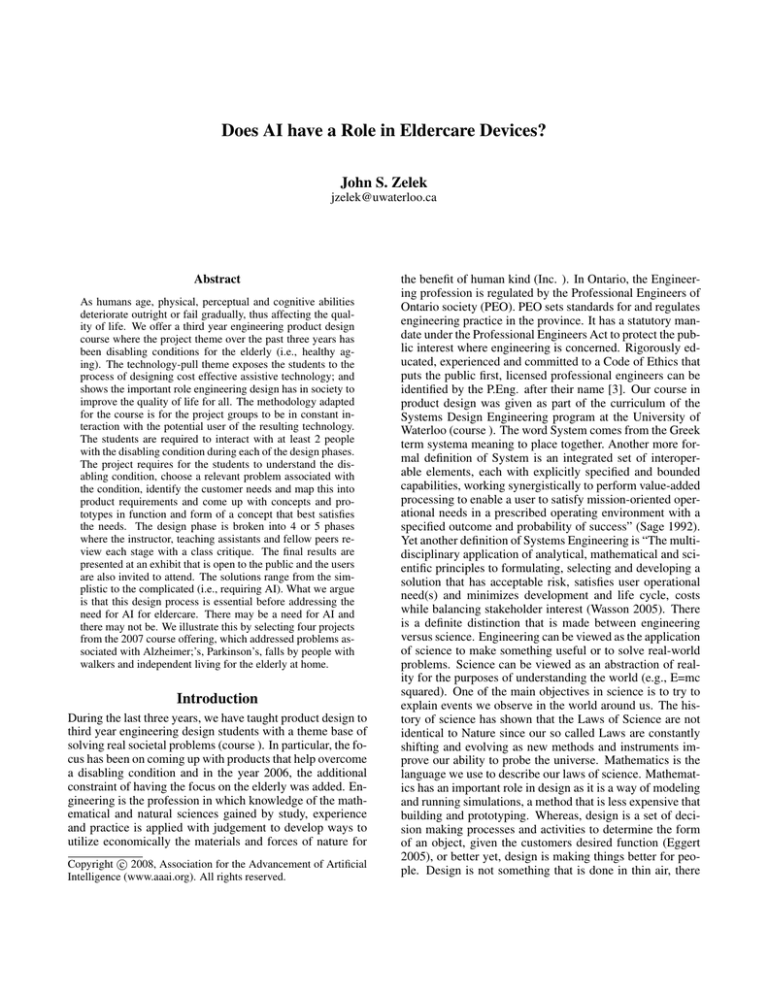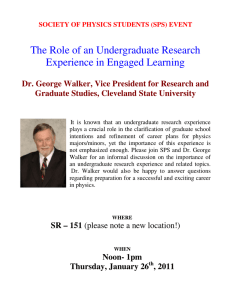
Does AI have a Role in Eldercare Devices?
John S. Zelek
jzelek@uwaterloo.ca
Abstract
As humans age, physical, perceptual and cognitive abilities
deteriorate outright or fail gradually, thus affecting the quality of life. We offer a third year engineering product design
course where the project theme over the past three years has
been disabling conditions for the elderly (i.e., healthy aging). The technology-pull theme exposes the students to the
process of designing cost effective assistive technology; and
shows the important role engineering design has in society to
improve the quality of life for all. The methodology adapted
for the course is for the project groups to be in constant interaction with the potential user of the resulting technology.
The students are required to interact with at least 2 people
with the disabling condition during each of the design phases.
The project requires for the students to understand the disabling condition, choose a relevant problem associated with
the condition, identify the customer needs and map this into
product requirements and come up with concepts and prototypes in function and form of a concept that best satisfies
the needs. The design phase is broken into 4 or 5 phases
where the instructor, teaching assistants and fellow peers review each stage with a class critique. The final results are
presented at an exhibit that is open to the public and the users
are also invited to attend. The solutions range from the simplistic to the complicated (i.e., requiring AI). What we argue
is that this design process is essential before addressing the
need for AI for eldercare. There may be a need for AI and
there may not be. We illustrate this by selecting four projects
from the 2007 course offering, which addressed problems associated with Alzheimer;’s, Parkinson’s, falls by people with
walkers and independent living for the elderly at home.
Introduction
During the last three years, we have taught product design to
third year engineering design students with a theme base of
solving real societal problems (course ). In particular, the focus has been on coming up with products that help overcome
a disabling condition and in the year 2006, the additional
constraint of having the focus on the elderly was added. Engineering is the profession in which knowledge of the mathematical and natural sciences gained by study, experience
and practice is applied with judgement to develop ways to
utilize economically the materials and forces of nature for
c 2008, Association for the Advancement of Artificial
Copyright Intelligence (www.aaai.org). All rights reserved.
the benefit of human kind (Inc. ). In Ontario, the Engineering profession is regulated by the Professional Engineers of
Ontario society (PEO). PEO sets standards for and regulates
engineering practice in the province. It has a statutory mandate under the Professional Engineers Act to protect the public interest where engineering is concerned. Rigorously educated, experienced and committed to a Code of Ethics that
puts the public first, licensed professional engineers can be
identified by the P.Eng. after their name [3]. Our course in
product design was given as part of the curriculum of the
Systems Design Engineering program at the University of
Waterloo (course ). The word System comes from the Greek
term systema meaning to place together. Another more formal definition of System is an integrated set of interoperable elements, each with explicitly specified and bounded
capabilities, working synergistically to perform value-added
processing to enable a user to satisfy mission-oriented operational needs in a prescribed operating environment with a
specified outcome and probability of success” (Sage 1992).
Yet another definition of Systems Engineering is “The multidisciplinary application of analytical, mathematical and scientific principles to formulating, selecting and developing a
solution that has acceptable risk, satisfies user operational
need(s) and minimizes development and life cycle, costs
while balancing stakeholder interest (Wasson 2005). There
is a definite distinction that is made between engineering
versus science. Engineering can be viewed as the application
of science to make something useful or to solve real-world
problems. Science can be viewed as an abstraction of reality for the purposes of understanding the world (e.g., E=mc
squared). One of the main objectives in science is to try to
explain events we observe in the world around us. The history of science has shown that the Laws of Science are not
identical to Nature since our so called Laws are constantly
shifting and evolving as new methods and instruments improve our ability to probe the universe. Mathematics is the
language we use to describe our laws of science. Mathematics has an important role in design as it is a way of modeling
and running simulations, a method that is less expensive that
building and prototyping. Whereas, design is a set of decision making processes and activities to determine the form
of an object, given the customers desired function (Eggert
2005), or better yet, design is making things better for people. Design is not something that is done in thin air, there
is a definite process to be followed. Real engineers do not
tinker. Tinker is defined as to repair, adjust or work with
something in an unskilled or experimental manner. Real engineers predict how a product will perform before building
it, reducing the need to trial by error (i.e., risk).
Design Course
Our third year design course in Systems Design Engineering emphasizes product design. The course material is presented in lecture form and the students are divided into design groups and there are individual one-on-one meetings
with the group and instructor and teaching assistants. The
group project reinforces the material taught in practice. Each
group chose a unique topic related to aged disability or
degradation of function. From this topic, each group is to
define a problem statement which is to be the measuring
stick (objective) that the design is to be evaluated against
at a high level. The course objective is to design a product. A product is an item that is purchased and used as a
unit. The course theme is to improve the quality of life of
someone who is aged. Some of the disabling conditions
available for the students to choose from have included:
AIDS/HIV; Allergies; Alzheimer’s Disease; Amputations;
Arthritis/Rheumatic Disease; Blood Disorders; Hepatitis;
Bone Disorders; Brain Injuries, Head; Burns; Cancer; Cerebral Palsy; Chronic Fatigue/Epstein-Barr; Deaf-Blindness;
Diabetes; Hearing Impairments, Deafness, Hard of Hearing; Heart Disorders; Kidney Disease; Language (Communication) Impairment; Leukemia; Mental Retardation,
and development disabilities (learning, cognitive); Pain;
Parkinson’s Disease; Psychological/Emotional Disabilities;
Vestibular (Balance) Disorders; Respiratory Disorders; Skin
Disorders; Smell and Taste Disorders; Spinal Cord Injury;
Stroke; Substance Abuse; Tactile Disorders; Tuberculosis
Sclerosia; and Visual Disabilities. Each group is to work
on a unique area and no 2 groups can work on the same
problem. This encourages support and constructive criticism from other groups and minimizes competition as two
projects topics are not alike. A need analysis is required to
be performed. Subsequently, product design requirements
are developed. Various concepts are generated and evaluated (preliminary design) and a concept is chosen. It has
been mandatory for each group to consult with at least one
person, preferably 2 or more, who is currently living with the
condition chosen. This is to assist in a better understanding
about the condition, its problems and to assist in determining the needs and testing of the concepts. Since design is
iterative, the groups are allowed to redo some of the steps as
needed. In order to engage in concept testing, the groups are
required to build a prototype to demonstrate function and to
also provide a computer model that demonstrates form, as
well as to provide analysis (e.g., electrical, mechanical) that
backs up the design. It is strongly encouraged to construct
prototypes early in the process, even if it is to be used as
a prop to solicit feedback for any stage, even the problem
statement. If you don’t fully understand the problem, how
can you design a solution for it? With the focus on coming
up with a physical prototype (proof of concept), the incorporation of AI (Artificial Intelligence), and its cognitive as-
sociations as well as its typical software manifestations, is
usually an after thought, after the underlying platform has
been constructed.
The course was divided up into five distinct phases: (1)
understanding the condition; (2) problem definition and getting to know the state of the art; (3) a needs analysis where
the customer needs are translated into product requirements;
(4) concepts generation, rationalize decisions and the selection of a winning concept to move forward with by testing
the ideas (with props) with users; and (5) prototype (synthesis) consisting of addressing function (does it work?, why?,
analysis) and form (what does it look like?). Aspects of the
course that were emphasized include: (1) tools and methods for product design; (2) iterative process such as the waterfall or spiral methods; (3) visualization of the process to
the users and instructors stressing communication styles and
brevity; (4) prototypes including mathematical models, virtual and physical stressing does it work and what does it
look and feel like; and (5) other issues such as sustainability,
economics and power consumption. With regards to design,
the emphasis was placed on process, team work, communication, user relevancy, innovation (methods), prediction
(mathe-matical models), iteration (many prototypes), analysis and synthesize again, and some discussion on the business and economic issues for the students who were inclined
to be entrepreneurial. The direction was more on technology
pull as opposed to technology push. At each phase of the
design process, user involvement was key. The user needs
begin the design process. A design does not have to be
new, different or impressive to be successful in the marketplace, as long as its fulfilling a need. A design is an activity
that translates an idea into a blueprint for something useful
(e.g., car, building, graphic, service, process). The theme of
disabilities and aging lent itself well for forcing technology
pull. The requirement of constant user feedback helps the
students to have empathy with the people they consult with,
the ones who have the disabling condition. There is also a
strong focus on the communication of ideas. The students
are forced to write concise executive summaries for every
stage of the design process. Every 2 weeks, the students presented a 5 minute presentation of their current work. During
this presentation, the groups are critiqued by their peers, instructor and teaching assistants. Each group meets with their
assigned teaching assistant once a week for an hour. At the
end of the semester, all the groups are involved in an exhibition where their prototypes are demonstrated in a forum that
is made available to the general public. Some form of media
attention has resulted from the first three years of offering
this course (2005-2007).
The students found the process rewarding as it addressed
real needs of the people they interacted with. It is our hope
by trying to make our course information available to all,
that some private enterprises might pick up the efforts of our
students and bring the products into existence in the market
place. There is also the possibility of others extending some
of the resulting technology. Some of the memorable projects
from 2006 included a walker with an embedded lift to improve home safety, a modified golf bag for the elderly golfer
who suffers from back pain and a bicycle helmet safety eval-
uator for the elderly who are physically active. Even though
that the products design were focused on a particular group,
it was observed that there were other verticals that would
find the products useful. This is in keeping with universal
design, where the objective is to design environments and
products usable by all without the need for adaptive solutions. The intent of universal design is to simplify life for all,
a holistic approach that accommodates people of all ages,
sizes and abilities (Guidelines ), (Wikipedia ). Our theme
based, user oriented approach to design appeared to get results (i.e., actual devices were built and demonstrated which
fulfilled a need).
Some Design Examples
For the purpose of illustration, we have selected four design
projects from the 2007 offering. These projects illustrate
how the design process has resulted in some practical simple solutions to some disabling conditions whereas other solutions could bootstrap an intelligent system (i.e., artificial
perception or cognition). Of the four projects highlighted,
it is only the reminder system, the one acting as a cognitive
prosthesis, for which AI could play a role. The other three
projects - a modified walker, an innovative electrical outlet
and a muscle stimulator - all result from a need that comes
from a physical disability. Perhaps this is significant, in that,
cognitive disabilities have a role for AI whereas physical disabilities may be aided by engineering solutions and AI may
be a nuisance as opposed to being an advantage.
Rollator’s Parking Brake System
A large concern for the elderly is forgetting to engage the
parking mechanism on the rollator (i.e., walker) before using
it as a seat or for support. Interviews and research indicate
that the elderly are prone to falling because of the dependence on memory to activate the rollator’s parking mechanism and also the inability of the current rollator to effectively park when the braking mechanism is engaged. Home
safety is an important aspect of life for the elderly; fall prevention is currently the most pressing issue amongst the elderly. It was found that falling while walking is the second
leading cause (29%) of hospitalization in all ages and accounts for 62% of hospitalization among seniors (of Canada
2005). A braking system was developed for a rollator that
will brake by default and thus will eliminate the need for
users to rely on memory to activate the parking mechanism.
Bilateral equal application of force was not necessary. The
amount of force required was not measured, although it is
similar to a bicycle braking system. Given issues of fatigue,
a drive by wire system might be appropriate; such a system would be adjustable to the user’s strength. The prototype demonstrated an innovative solution to the forgetting
of braking a walker; refinements are definitely required to
address these and other issues if this platform is to be deployed. This type of solution is very mechanical and not
really of need for AI.
Outside this course project, a group of us at UW are engaged in an intelligent walker project that includes artificial
perception and cognition. A smart walker can be the as-
sistive device that can help our aging population: providing them with mobility that provides exercise and general
health; predicting dangerous situations before they occur
such as falls; and acting as a general communication portal to caretakers. There has been a lot of research devoted to
intelligent wheelchairs, yet the cane and walker are used by
more than four times as many people, totaling 6.5 million in
the US. A walker assists in general mobility and well-being
even with a decline in the general state-of-health of the user.
Elderly people are prepared to risk their own health in order to maintain their independence and lifestyle. We have
worked together with the Toronto Rehab Institute in developing intelligent instrumentation to help in assessing and understanding the effectiveness of a walker in a nursing home
setting. The walker will not only play the role of being an assistive mobility aid, but could also play multiple roles such
as coach, caretaker and as a social communication portal.
The walker will be able to: continuously monitor and predict
the stability and potential falls of the user; verify the proper
use of the walker; anticipate potential hazards and warn the
user; report on the physiological state of the user; automatically brake if necessary. Whether the device is solely used
as a clinical observation platform or an integrated platform
will provide the answer to whether AI has a role to play in
the walker. That role could provide a way of predicting hazards that are likely to occur and guide the user to safety.
An electrical outlet for the elderly
Through loss of dexterity, balance, strength and vision, an
ever-growing number of elderly people are experiencing significant impediments to independent living in the home. In
particular, the elderly have difficulty plugging and unplugging electrical devices due to the three-prong outlet and plug
design. A solution has been designed that will improve accessibility, visibility, and decrease the need for user dexterity
such that the elderly require reduced effort plugging and unplugging electrical devices. The design is a three concentric
ring magnetic plug and outlet adapter: one of these rings
being the ground and the other two for the current to flow
through. The final concept fits the standard plug and outlet offering a new interface that is orientation independent,
easy-to-insert and highly visible. The inspiration for the outlet was the AC adapter for Apple laptops. Again, since the
need is purely physical and not cognitive, an engineering solution (without AI) addresses the problem best.
A Reminder System for Alzheimer’s
The inhibiting nature of semantic and short-term memory
loss caused by Alzheimers disease (AD) severely impedes
the ability of an individual to perform routine tasks. In order to enhance the independence of these individuals, a device that aids with the completion of daily hygiene related
tasks in the bathroom through a sequence of prompts has
been designed. The feedback for the design was chiefly obtained from caretakers. The users engage with instructional
animations on a screen coupled with auditory prompts and
compact modules containing hygiene tools that are packaged
with a series of lights which visually highlight the next required tool. Sensors positioned to detect the presence of a
user trigger these components. This prototype provides sensors and actuation units (lights, prompts) which can be mitigated with some intelligent processing to monitor responses,
hygiene activity, etc.
The point of this paper is to show that a thorough design
process will either define a place for AI in a system for eldercare or might define no place for it. In general, physical
ailments do not necessitate an AI component but ones with
a cognitive aspect do.
Parkinson’s: A device to help people stand
The most common symptoms of Parkinsons Disease affect
the movement of the patients. These are also the better
known symptoms associated with the disease as they are
the most observable effects. These symptoms are muscle
tremors and rigidity, slow movement and impaired balance.
There are also other symptoms of Parkinsons Disease, which
are not motor related. These symptoms also tend to be less
frequently occurring than the movement impairments. Some
of these symptoms include soft speech, difficulty with handwriting, stooped posture, sleep disturbances and cognitive
impairments such as memory loss, depression and anxiety.
It is important to note that every patient experiences different combinations and degrees of the symptoms mentioned
above. The rate of progression of the disease is also variable amongst patients (for Parkinson Research ). A device
was designed to help people with Parkinson’s to get out of
a chair. The idea behind this device is to follow the persons lower back as they rise out of a chair, and to prevent
them from falling backwards into the chair by locking if
their motion reverses. A vibrating device was strapped to
each leg which can be activated when a person wants to get
out of a chair. Vibrations at a certain frequency (nominally
we used 70 to 90 Hz) activate the muscle sensory nerves
as if the muscle were lengthening, producing an automatic
contraction reflex response through the spinal cord (Naito
1999). On the correct muscle, at the correct time, this reflex response could help a person with Parkinsons Disease
to rise from a chair. The vibrating muscle stimulator was
selected based primarily on the effectiveness in addressing
user needs, feasibility of construction and the ability to design a technology that has not been explored fully. When rising from the chair, the quadricepses are required to work in
tandem with the hamstrings: the quadricepses stretch, then
relax, at which point the hamstrings stretch. In order for
the quadriceps to relax, a control signal must be sent from
the brain; this control signal is not sent until a feedback signal is received from the quadriceps, indicating that they are
stretched (Almeida 2007). The force produced was 25 N
and this force and frequency appeared to be effective. We
are not sure if this setting (frequency and force) is universal
(correlated with some inherent muscle activation threshold
for the human body) or depends on the person’s strength.
The device is purely physical need driven and a mechanical and electrical solution appear to be effective without any
need for artificial reasoning.
So where does the AI fit in?
For the example designs given in the previous section, the
walker and reminder system have a place where AI can contribute, either intelligent perception for the walker or intelligent cognition for the reminder system. The other two designs do not warrant any AI yet provide a satisfying solution.
References
Almeida, Q. 2007. personal communication. Wilfred Laurier University.
Course, P. D. http://www.uwaterloo.ca/ jzelek/teaching
/syde361/syde361.html.
Eggert, R. J. 2005. Engineering Design. Prentice Hall.
M.
J.
F.
F.
for
Parkinson
Research.
http://www.michaeljfox.org/index.cfm.
U. A. A. Guidelines.
http://www.accessboard.gov/adaag/html/adaag.htm.
A. Inc. http://www.abet.org.
Naito, E. 1999. Illusory arm movements activate cortical
motor areas: a positron emission tomography study. The
Journal of Neuroscience 19(14):6134–6144.
P. H. A. of Canada. 2005. Report on seniors’ falls in
canada. Technical report, Minister of Public Works and
Government Services Canada.
Sage, A. P. 1992. Systems Engineering. Wiley.
Wasson, C. S. 2005. System Analysis, Design, and Development: Concepts, Principles, and Practice. Wiley.
Wikipedia, U. D. http://en.wikipedia.org/wiki/universaldesign.





